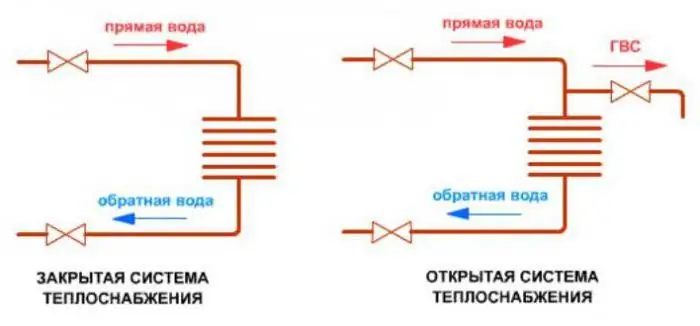2025 Author: Howard Calhoun | [email protected]. Last modified: 2025-01-24 13:10:38
For space heating, a closed and open heat supply system is used. The latter option additionally provides the consumer with hot water. At the same time, it is necessary to control the constant replenishment of the system.
Closed system uses water only as a heat transfer medium. It constantly circulates in a closed loop, where losses are minimal.

Any system consists of three main parts:
- heat source: boiler room, CHP, etc.;
- heat networks through which the coolant is transported;
- heat consumers: heaters, radiators.
Features of an open system
The advantage of an open system is its economy. Due to the long length of pipelines, the quality of water is deteriorating: it becomes cloudy, acquires color, hasbad smell. Trying to clean it makes it expensive to use.
Heating pipes can be seen in big cities. They have a large diameter and are wrapped in a heat insulator. Branches are made from them to individual houses through a thermal substation. Hot water is supplied for use to heating radiators from a common source. Its temperature fluctuates between 50-75°C.
Heat supply is connected to the network in dependent and independent ways, implementing closed and open heat supply systems. The first is to supply water directly - using pumps and elevator units, where it is brought to the required temperature by mixing with cold water. An independent way is to supply hot water through a heat exchanger. It is more expensive, but the quality of water at the consumer is higher.
Features of a closed system
The heat main is made as a separate closed circuit. The water in it is heated through heat exchangers from the CHP main. Additional pumps are required here. The temperature regime is more stable, and the water is better. It remains in the system and is not taken by the consumer. Minimal water losses are restored by automatic make-up.
Closed autonomous system receives energy from the coolant supplied to the heating points. There, the water is brought to the required parameters. Different temperature regimes are supported for heating and hot water systems.
The disadvantage of the system is the complexity of the water treatment process. It is also expensive to deliver water to thermallocations far apart.
Heat network pipes
Currently, domestic heating networks are in disrepair. Due to the high wear and tear of communications, it is cheaper to replace pipes for heating mains with new ones than to engage in constant repairs.
It is impossible to immediately update all the old communications in the country. During the construction or overhaul of houses, new pipes in polyurethane foam insulation (PPU) are installed, which reduce heat loss by several times. Pipes for heating mains are made according to a special technology, filling the gap between the steel pipe located inside and the shell with foam.

The temperature of the transported liquid can reach 140°C.
The use of PU foam as thermal insulation allows you to retain heat much better than traditional protective materials.
Heat supply for apartment buildings
Unlike a dacha or a cottage, the heat supply of an apartment building contains a complex scheme of piping and heaters. In addition, the system includes controls and security.
For residential premises, there are heating standards, which indicate critical temperature levels and permissible errors, depending on the season, weather and time of day. If we compare closed and open heating systems, the first one better supports the required parameters.
Communal heat supply must ensure that the main parameters are maintained in accordance with GOST 30494-96.

The greatest heat loss occurs in the stairwells of residential buildings.
Heat supply is mostly produced by old technologies. Essentially, heating and cooling systems should be combined into a common complex.
Disadvantages of centralized heating of residential buildings lead to the need to create individual systems. It is difficult to do this due to problems at the legislative level.
Autonomous heating of a residential building
In the buildings of the old type, the project provides for a centralized system. Individual schemes allow you to choose the types of heat supply systems in terms of reducing energy costs. Here it is possible to turn them off mobile if not necessary.

Autonomous systems are designed taking into account heating standards. Without this, the house cannot be put into operation. Following the norms guarantees comfort for the residents of the house.
The source of water heating is usually a gas or electric boiler. It is necessary to choose a method for flushing the system. In centralized systems, the hydrodynamic method is used. For standalone, you can use a chemical. In this case, it is necessary to take into account the safety of the influence of reagents on radiators and pipes.
Legal basis for relations in the field of heat supply
Relations between energy companies and consumers are regulated by the Federal Law on heat supply No. 190, which entered into force in 2010
- Chapter 1 introduces the basic concepts and generalprovisions defining the scope of the legal foundations of economic relations in heat supply. It also includes provision of hot water. General principles for the organization of heat supply are approved, which consist in the creation of reliable, efficient and developing systems, which is very important for living in the difficult Russian climate.
- Chapters 2 and 3 reflect the vast area of authority of local authorities that manage pricing in the heat supply sector, approve the rules for its organization, accounting for heat energy consumption and standards for its losses during transmission. The completeness of power in these matters allows you to control the heat supply organizations related to monopolists.
- Chapter 4 reflects the relationship between the heat supplier and the consumer on the basis of a contract. All legal aspects of connection to heating networks are considered.
- Chapter 5 reflects the rules for preparing for the heating season and repairing heating networks and sources. It describes what to do in case of non-payment under the contract and unauthorized connections to heating networks.
- Chapter 6 defines the conditions for the transition of an organization to the status of a self-regulating in the field of heat supply, the organization of the transfer of rights to own and use a heat supply facility.
Users of heat energy should be aware of the provisions of the Federal Law on heat supply in order to assert their legal rights.

Drafting a heat supply scheme
The heat supply scheme is a pre-project document that reflects legal relations, conditionsfunctioning and development of the system for providing heat to the urban district, settlement. In relation to it, the federal law includes certain norms.
- Heat supply schemes for settlements are approved by executive authorities or local governments, depending on the population.
- There should be a single heat supply organization for the respective territory.
- The scheme indicates energy sources with their main parameters (load, work schedules, etc.) and range.
- Measures are indicated for the development of the heat supply system, the conservation of excess capacity, and the creation of conditions for its uninterrupted operation.

Heat supply facilities are located within the boundaries of the settlement according to the approved scheme.
Purposes of applying the heat supply scheme
- definition of a single heat supply organization;
- determining the possibility of connecting capital construction facilities to heat networks;
- inclusion of measures for the development of heat supply systems in the investment program of the organization of heat supply.

Conclusion
If we compare closed and open heat supply systems, the introduction of the first is currently promising. Hot water supply improves the quality of the water supplied to the level of drinking water.
Despite the fact that new technologies are resource-saving and reduce emissions into the atmosphere, they require significantinvestment. At the same time, there is a lack of qualified specialists due to the lack of special personnel training and low wages.
Methods of implementation are at the expense of commercial and budgetary financing, competitions for investment projects and other events.
Recommended:
Electronic document management: advantages and disadvantages, the essence of the system, ways of implementation

The article presents the advantages of electronic document management, and also lists the main steps to implement it in the work of any enterprise. The shortcomings of this system are indicated, as well as the main difficulties that the owners of firms have to face
System approach to management. Advantages and disadvantages

Now more and more businessmen realize the value of such a science as management. This includes many different directions on the most incredible topics. It is a systematic approach to management that allows you to optimize all stages of work at the enterprise, which in turn will certainly lead to a reduction in costs. It views your company as a single organism, made up of many separate pieces and elements, focusing on the connection between them
Common taxation system: advantages and disadvantages, transition

The general taxation system is considered the most complex regime in the Russian Federation. The article describes how you can switch to this system. All taxes that individual entrepreneurs and companies have to calculate and pay are listed. Various declarations and reports that need to be submitted to the Federal Tax Service on a regular basis are indicated
Market "Gardener" will be closed? Market "Gardener" closed or not?

Since the summer of last year, there has been an active discussion of the issue of closing the Sadovod market. After the well-known events in Biryulyovo, this object became the next one, and the authorities seriously thought about what to do. Many people ask the question of whether the Sadovod market was closed or not
A closed joint stock company is A joint stock company open and closed

A closed joint stock company is a commercial organization that is opened by one or more founders. These can be foreign citizens or nationals of the country in which the company is opened, but their number should not exceed 50 people

